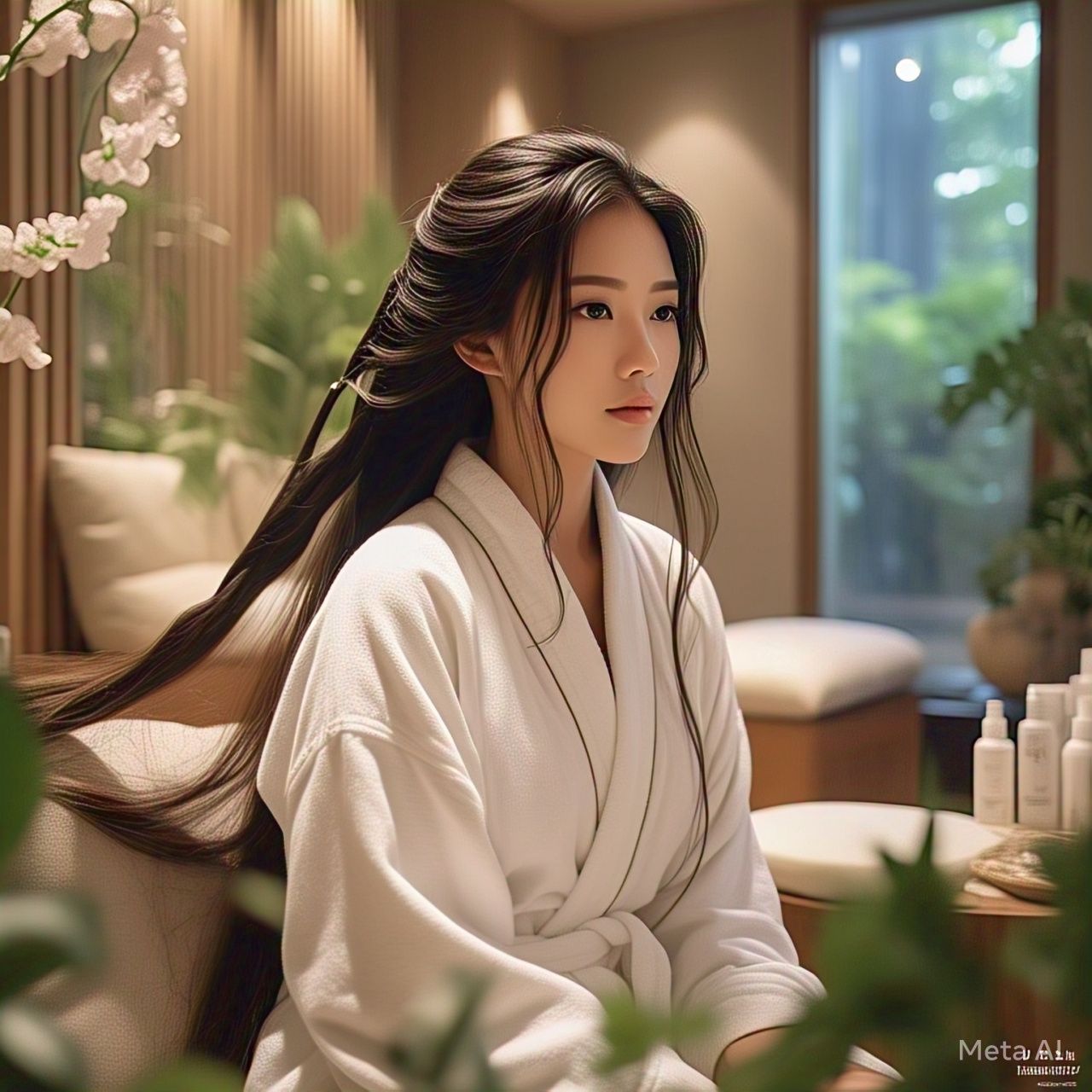Understanding Long Asian Hair and Its Unique Needs
Long Asian hair is admired for its sleek, shiny, and strong appearance. However, maintaining its health and beauty requires a specialized approach. Unlike other hair types, Asian hair tends to be thicker, straighter, and more resistant to styling. It also has unique challenges, such as dryness, frizz, and scalp issues.
This article provides a comprehensive, step-by-step hair care routine designed specifically for long Asian hair. By understanding its structure and common problems, individuals can adopt practices that enhance shine, strength, and manageability.
The Structure of Asian Hair
Asian hair is known for its round and thick follicle structure. Each strand has a larger diameter compared to Caucasian or African hair, making it stronger but also heavier. The cuticle layer is tightly packed, which contributes to its smooth texture. However, this density can also make it harder for moisture to penetrate, leading to dryness.
Another key characteristic is its high melanin content, giving it a deep black or dark brown color. While this provides natural UV protection, it also means that chemical treatments like bleaching can be more damaging.
Common Challenges with Long Asian Hair
Despite its strength, long Asian hair faces several challenges. One major issue is dryness. Because the hair shaft is thick, natural oils from the scalp struggle to travel down the length, leaving the ends parched. This can lead to split ends and breakage.
Another problem is frizz. Humidity affects Asian hair significantly, causing the cuticles to lift and creating a fuzzy appearance. Additionally, the weight of long hair can cause tension on the scalp, leading to hair loss if not managed properly.
The Importance of a Tailored Hair Care Routine
Generic hair care routines often fail to address the specific needs of Asian hair. A proper routine should focus on deep hydration, scalp health, and gentle handling. Using the right products, avoiding excessive heat, and incorporating protective styles can make a significant difference.
In the next section, the article will delve into the best cleansing and conditioning practices for long Asian hair, ensuring that each step contributes to stronger, shinier, and healthier locks.
Understanding the unique properties of long Asian hair is the first step toward an effective hair care routine. Its thickness, density, and resistance to moisture require specialized attention. By recognizing common issues like dryness, frizz, and scalp tension, individuals can take proactive steps to maintain their hair’s health. The next part will explore the best washing and conditioning techniques to keep Asian hair nourished and vibrant.
The Best Cleansing and Conditioning Practices
Washing and conditioning are the foundations of any hair care routine. For long Asian hair, these steps must be carefully chosen to prevent stripping natural oils while ensuring deep hydration. Many people make the mistake of overwashing or using harsh shampoos, which can lead to dryness and breakage.
This section will guide readers through the best cleansing and conditioning methods, including product selection, washing frequency, and techniques to maximize moisture retention.
Choosing the Right Shampoo
Not all shampoos are created equal, especially for Asian hair. Sulfate-free shampoos are highly recommended because they cleanse without stripping essential oils. Look for ingredients like hyaluronic acid, argan oil, or glycerin, which help retain moisture.
Clarifying shampoos should be used sparingly—once every two weeks—to remove product buildup without causing excessive dryness. For those with oily scalps, a balancing shampoo with tea tree oil or charcoal can regulate sebum production.
How Often Should You Wash Asian Hair?
A common misconception is that hair must be washed daily. However, overwashing can disrupt the scalp’s natural oil balance. For long Asian hair, washing two to three times a week is ideal. Those with very dry hair might even extend it to once a week, using dry shampoo in between if needed.
On non-wash days, rinsing with lukewarm water can help refresh the hair without stripping moisture.
Conditioning for Maximum Hydration
Conditioner is non-negotiable for long Asian hair. A silicone-free, deeply hydrating conditioner should be applied from mid-length to ends, avoiding the scalp to prevent greasiness. For extra nourishment, a leave-in conditioner or hair mask once a week can repair damage and improve elasticity.
Cold water rinses after conditioning can help seal the cuticles, enhancing shine and reducing frizz.
The Role of Hair Oils and Serums
Natural oils like coconut, jojoba, or camellia oil are excellent for sealing in moisture. Applying a few drops to damp hair can prevent frizz and add a healthy sheen. Serums with heat protection should be used before styling to minimize damage.
Proper cleansing and conditioning are crucial for maintaining long Asian hair’s health. By selecting sulfate-free shampoos, washing less frequently, and using deep-conditioning treatments, individuals can prevent dryness and breakage. The next section will explore effective drying and detangling techniques to minimize damage.
Proper Drying and Detangling Techniques to Prevent Damage
After cleansing and conditioning, the next critical steps in a hair care routine are drying and detangling. Many people unknowingly cause breakage and frizz by using harsh towel-drying methods, excessive heat, or rough brushing. For long Asian hair—which is thick, dense, and prone to dryness—gentle handling is key to maintaining smoothness and strength.
This section will cover the best practices for drying and detangling Asian hair, including towel alternatives, heat protection, and the right tools to minimize damage.
The Problem with Traditional Towel Drying
Most people rub their hair vigorously with a regular bath towel after washing, but this is one of the worst habits for long hair. The rough texture of cotton towels can lift the hair cuticles, leading to frizz and breakage. Additionally, the friction weakens strands, making them more prone to split ends.
A better alternative is using a microfiber towel or an old cotton T-shirt. These materials are softer and absorb water without causing excessive friction. The hair should be gently squeezed (not rubbed) to remove excess moisture before proceeding to air-drying or heat styling.
Air-Drying vs. Blow-Drying: Which Is Better?
The Benefits of Air-Drying
Air-drying is the gentlest method and helps retain moisture. However, leaving hair wet for too long can cause hygral fatigue, where repeated swelling and shrinking of the hair shaft weakens the protein structure. To prevent this, hair should not stay damp for more than a few hours.
For those who air-dry, flipping the hair side to side occasionally helps it dry evenly. Applying a lightweight leave-in conditioner or anti-frizz serum beforehand can also enhance smoothness.
When Blow-Drying Is Necessary
In humid climates or for people with dense hair, air-drying may take too long, increasing the risk of fungal growth or odor. In such cases, blow-drying on low heat is a better option.
Key tips for safe blow-drying:
- Use a heat protectant spray before styling.
- Keep the dryer at least 6 inches away from the hair.
- Use the cool shot button to seal the cuticles at the end.
- Opt for an ionic dryer, which reduces frizz by neutralizing static.
The Right Way to Detangle Long Asian Hair
Long Asian hair is prone to tangling, especially when wet. Improper brushing can lead to mechanical damage, where strands snap or stretch beyond recovery.
Step-by-Step Detangling Method
- Start with Fingers First – Before using a brush, gently separate large tangles with fingers.
- Use a Wide-Tooth Comb – Begin from the ends and slowly work upward to avoid pulling.
- Apply a Detangling Spray – A lightweight mist with slip (like those containing behentrimonium chloride) helps ease knots.
- Never Brush Wet Hair Aggressively – Wet hair is more elastic and vulnerable to breakage.
Choosing the Right Brush
- Wide-tooth comb – Best for wet hair.
- Boar bristle brush – Distributes natural oils on dry hair.
- Tangle Teezer – Gentle on knots without pulling.
Avoiding Common Mistakes
- Brushing from the roots down – This tightens knots and causes breakage.
- Using fine-tooth combs on wet hair – Creates unnecessary tension.
- Skipping heat protection – Leads to dryness and split ends over time.
Drying and detangling may seem like simple steps, but they play a huge role in preventing damage to long Asian hair. Switching to microfiber towels, minimizing heat exposure, and using the right detangling tools can make hair stronger and smoother.
Protective Styling and Long-Term Maintenance for Healthy Hair
Maintaining long, healthy Asian hair doesn’t stop at washing and conditioning—how you style and protect your hair daily plays an equally important role. Many common hairstyles and habits, such as tight ponytails, excessive heat styling, and neglecting nighttime care, contribute to breakage and thinning over time.
This final section will cover protective styling techniques, nighttime routines, and long-term maintenance strategies to keep Asian hair strong, shiny, and free from damage.
Why Protective Styling Matters for Long Asian Hair
Asian hair is naturally thick and heavy, which means constant tension from tight hairstyles can weaken the roots and lead to traction alopecia (hair loss caused by pulling). Additionally, environmental factors like humidity, pollution, and friction from clothing (e.g., wool scarves) can cause dryness and split ends.
Protective styling helps by:
- Minimizing daily manipulation (less brushing and heat exposure).
- Reducing friction against fabrics and external elements.
- Preventing moisture loss by keeping ends tucked away.
Best Protective Hairstyles for Long Asian Hair
- Loose Braids or Twists
- Keeps hair secure without excessive tension.
- Ideal for sleeping to prevent tangling.
- Low Buns or Chignons
- Avoids strain on the hairline.
- Use silk scrunchies instead of elastic bands to reduce breakage.
- Half-Up, Half-Down Styles
- Reduces stress on roots while keeping hair manageable.
- Claw Clips Instead of Hair Ties
- Distributes pressure more evenly than tight elastics.
Hairstyles to Avoid:
- Tight high ponytails (causes stress on the scalp).
- Excessive heat-straightened styles (leads to dryness and brittleness).
- Overuse of extensions (can pull on natural hair).
Nighttime Hair Care Routine for Damage Prevention
While we sleep, friction from cotton pillowcases can cause breakage, frizz, and split ends. A proper nighttime routine ensures hair stays smooth and hydrated.
Step-by-Step Nighttime Routine
- Detangle Before Bed
- Gently brush hair with a boar bristle brush to distribute natural oils.
- Apply a Lightweight Oil or Serum
- Focus on the ends to prevent dryness overnight.
- Oils like argan, jojoba, or camellia work well.
- Protective Style for Sleeping
- A loose braid or low bun prevents tangling.
- Alternatively, wrap hair in a silk or satin scarf.
- Switch to a Silk Pillowcase
- Reduces friction significantly compared to cotton.
- Helps retain moisture and prevents bedhead.
Long-Term Maintenance: Trims, Treatments, and Diet
Regular Trims Are Non-Negotiable
Even with the best care, split ends will eventually appear. Getting a trim every 8-12 weeks prevents them from traveling up the hair shaft and causing further damage.
Deep Conditioning Treatments
- Use a hydrating hair mask once a week.
- Look for ingredients like keratin, shea butter, or hydrolyzed proteins for repair.
Scalp Health = Hair Growth
- Massage the scalp 2-3 times a week to stimulate blood flow.
- Use a scalp serum with caffeine or rosemary oil if experiencing thinning.
Nutrition for Stronger Hair
Asian hair thrives with proper internal care. Key nutrients include:
- Biotin & Collagen (strengthens strands).
- Omega-3s (found in fish, flaxseeds—boosts shine).
- Iron & Zinc (prevents excessive shedding).










